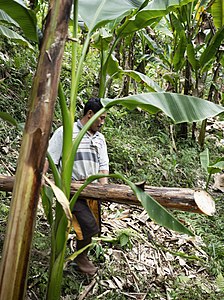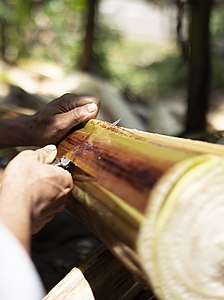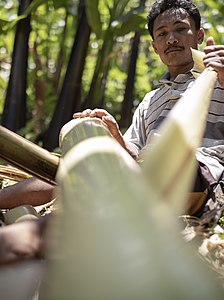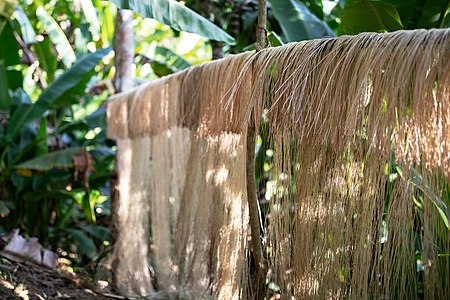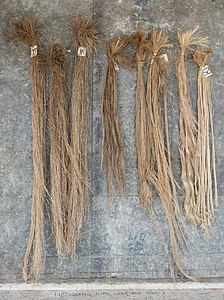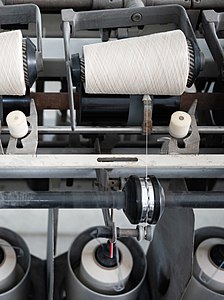
Textile is an umbrella term that includes various fiber-based materials, including fibers, yarns, filaments, threads, different fabric types, etc. At first, the word "textiles" only referred to woven fabrics. However, weaving is not the only manufacturing method, and many other methods were later developed to form textile structures based on their intended use. Knitting and non-woven are other popular types of fabric manufacturing. In the contemporary world, textiles satisfy the material needs for versatile applications, from simple daily clothing to bulletproof jackets, spacesuits, and doctor's gowns.

Weaving is a method of textile production in which two distinct sets of yarns or threads are interlaced at right angles to form a fabric or cloth. Other methods are knitting, crocheting, felting, and braiding or plaiting. The longitudinal threads are called the warp and the lateral threads are the weft, woof, or filling. The method in which these threads are interwoven affects the characteristics of the cloth. Cloth is usually woven on a loom, a device that holds the warp threads in place while filling threads are woven through them. A fabric band that meets this definition of cloth can also be made using other methods, including tablet weaving, back strap loom, or other techniques that can be done without looms.

Linen is a textile made from the fibers of the flax plant.

Catanduanes, officially the Province of Catanduanes, is an island province located in the Bicol Region of Luzon in the Philippines. It is the 12th-largest island in the Philippines, and lies to the east of Camarines Sur, across the Maqueda Channel. Its capital is Virac. It had a population of 271,879 people as of the 2020 census.

Fiber crops are field crops grown for their fibers, which are traditionally used to make paper, cloth, or rope.

Hemp, or industrial hemp, is a plant in the botanical class of Cannabis sativa cultivars grown specifically for industrial and consumable use. It can be used to make a wide range of products. Along with bamboo, hemp is among the fastest growing plants on Earth. It was also one of the first plants to be spun into usable fiber 50,000 years ago. It can be refined into a variety of commercial items, including paper, rope, textiles, clothing, biodegradable plastics, paint, insulation, biofuel, food, and animal feed.
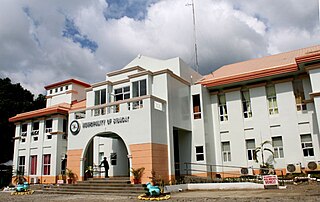
Sibagat, officially the Municipality of Sibagat, is a 1st class municipality in the province of Agusan del Sur, Philippines. According to the 2020 census, it has a population of 33,957 people.
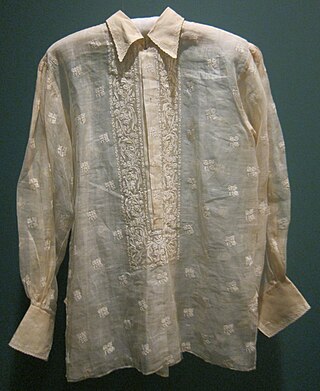
The barong tagalog, more commonly known simply as barong, is an embroidered long-sleeved formal shirt for men and a national dress of the Philippines. Barong tagalog combines elements from both the precolonial native Filipino and colonial Spanish clothing styles. It is traditionally made with sheer textiles (nipis) woven from piña or abacá; although in modern times, cheaper materials like organza silk, ramie or polyester are also used.

A manila folder is a file folder designed to contain documents, often within a filing cabinet. It is generally formed by folding a large sheet of stiff card in half. Though traditionally buff, sometimes other colors are used to differentiate categories of files.

Manila paper is a relatively inexpensive type of paper, generally made through a less-refined process than other types of paper, and is typically made from semi-bleached wood fibers.

Piña is a traditional Philippine fiber made from the leaves of the pineapple plant. Pineapples are indigenous to South America but have been widely cultivated in the Philippines since the 17th century, and used for weaving lustrous lace-like luxury textiles known as nipis fabric. The name is derived from Spanish piña, meaning "pineapple".
The manufacture of textiles is one of the oldest of human technologies. To make textiles, the first requirement is a source of fiber from which a yarn can be made, primarily by spinning. The yarn is processed by knitting or weaving, which turns yarn into cloth. The machine used for weaving is the loom. For decoration, the process of colouring yarn or the finished material is dyeing. For more information of the various steps, see textile manufacturing.
The United Nations General Assembly declared 2009 as the International Year of Natural Fibres (IYNF), as well as the International Year of Astronomy.
The study of the history of clothing and textiles traces the development, use, and availability of clothing and textiles over human history. Clothing and textiles reflect the materials and technologies available in different civilizations at different times. The variety and distribution of clothing and textiles within a society reveal social customs and culture.

Musa basjoo, known variously as Japanese banana, Japanese fibre banana or hardy banana, is a species of flowering plant belonging to the banana family Musaceae. It was previously thought to have originated in the Ryukyu islands of southern Japan, from where it was first described in cultivation, but is now known to have originated in subtropical southern China, where it is also widely cultivated, with wild populations found in Sichuan province. Its specific name is derived from its Japanese common name, bashō (芭蕉).

Tnalak, is a weaving tradition of the Tboli people of South Cotabato, Philippines. T'nalak cloth is woven exclusively by women who have received the designs for the weave in their dreams, which they believe are a gift from Fu Dalu, the T'boli Goddess of abacá.

Kijōka-bashōfu (喜如嘉の芭蕉布) is the Japanese craft of making cloth from the bashō or Japanese fibre banana as practiced in Kijōka in Ogimi, Okinawa. Like linen, hemp, ramie and other long vegetable fibres, it does not stick to the skin in hot weather; as such it is suitable for the climate of Okinawa. Kijōka-bashōfu is recognized as one of the Important Intangible Cultural Properties of Japan.
Abaca bunchy top virus (ABTV) is a pathogenic plant virus of the family Nanoviridae. ABTV has been isolated from both abacá (Musa textilis) and banana (Musa sp.). ABTV has many similarities to banana bunchy top virus (BBTV) but is both genetically and serologically distinct in that it lacks two open reading frames found in BBTV's genome. ATBV's genome contains six circular components, each of which are 1,000-1,500 base pairs in length.

Leaf fibers or hard fibers are a type of plant fiber mainly used for cordage. They are the toughest of the plant fibers which is most likely due to their increased lignin content when compared to the other groups of plant fibers. They are typically characterized as being very tough and rigid lending them towards being used in rope production over clothing or paper like other plant fibers.

Bananatex is a natural cellulosic biodegradable "technical" canvas fabric made of Abacá banana plant fibres. The plants are grown in the Philippines as part of a sustainable forestry project in Catanduanes. Bananatex was developed and is distributed by the Swiss canvas goods company QWSTION and is used in the company's own products as well as in other companies' manufactured goods. Bananatex was developed to have better wear characteristics than cotton while being more sustainable. It is less durable than synthetics like Cordura, and can biodegrade. Bananatex is sold in a range of colours and is available with or without a natural beeswax waterproof coating.





